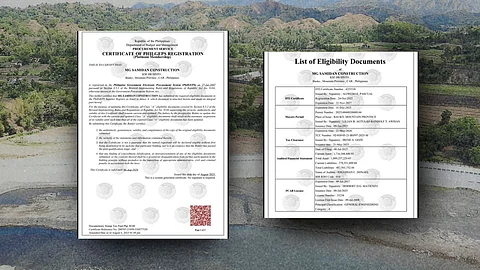
- NEWS
- the EDIT
- COMMENTARY
- BUSINESS
- LIFE
- SHOW
- ACTION
- GLOBAL GOALS
- SNAPS
- DYARYO TIRADA
- MORE

After President Ferdinand Marcos Jr. revealed a list of 15 contractors cornering nearly P100 billion in flood-control projects, and Senator Panfilo Lacson’s recent privilege speech on systemic abuse in public works funding, the floodgates burst wide open. What was once hidden behind layers of bureaucracy and ribbon-cuttings is now under scrutiny: the quiet but decisive role of Congress in shaping which projects the Department of Public Works and Highways (DPWH) actually builds.
At the center of the controversy is MG Samidan, whose name appeared in Marcos’ disclosures. Confusion erupted when records showed a corporate entity with only P250,000 paid-up capital, raising questions about how it qualified for billion-peso contracts.
In an exclusive interview, Kevin Samidan, son of company owner Marjorie Olsim Samidan, clarified:
“Magkaiba po talaga yan. (It is really different.) The corporation has P250,000 paid-up capital, but it has no PCAB license and is not used for bidding. What we actually use is MG Samidan Construction, the sole proprietorship, which holds the PCAB license and has the financial capacity to qualify for big projects.”
Documents obtained by the Tribune confirm this claim:
SEC Certificate of Incorporation (2019) – M.G. Samidan Construction and Development Corporation, P250,000 paid-up capital
DTI Business Name Registration (2022–2027) – MG Samidan Construction, sole proprietorship under Marjorie Samidan
PCAB License No. 33234, Category A – General Engineering, first issued in 2008
Audited Financial Statement – P1.8 billion in total assets, P1.7 billion in current assets
Kevin further disclosed that the firm has completed at least 61 projects from 2020 to 2024, including flood-control works in Ilocos Norte.
While critics highlight the P250,000 figure, MG Samidan argues that what truly matters is Net Financial Contracting Capacity (NFCC), the standard measure in government procurement to determine if a contractor can handle projects.
NFCC is computed as:
(Current Assets – Current Liabilities) × 15 – Value of Ongoing Projects
In MG Samidan’s case, the math checks out. With P1.7 billion in current assets and P378 million in liabilities, its NFCC stands at P1.3 billion, enough to qualify for billion-peso flood-control works.
“A sole proprietorship doesn’t have paid-up capital like a corporation. What matters is the NFCC, and ours is strong enough,” Kevin explained.
On allegations of ghost projects, “kaltas” to district engineers, and padrino politics, Kevin was unequivocal:
“Wala po kaming binibigay. (We did not give any bribe.) Our projects are completed, no ghost projects, and our profits are within the 8–10% contractor’s margin allowed by law.”
Past slippages in 2017–2018, he said, were caused by weather disruptions validated by PAGASA reports, with projects eventually completed.
On paper, DPWH projects follow a clean cycle: needs assessment, feasibility studies, DBM review, congressional approval through the General Appropriations Act (GAA), bidding under Republic Act 9184, construction, and audit.
In practice, the money trail tells a different story. Lawmakers, not engineers, decide what gets built. Projects rise or fall based on congressional lobbying and budget insertions.
A budget insertion is an allocation slipped into the national budget, often during closed-door bicameral sessions. Some address genuine needs; others mimic the pork barrel system, funneling funds to allies or favored contractors.
Even after the Supreme Court declared the Priority Development Assistance Fund (PDAF) unconstitutional in 2013, lawmakers found new levers of control. The bicameral conference committee became the new Pandora’s box where billions could quietly shift.
Marcos’ disclosures and Lacson’s speech opened that box further. What had long been whispered that DPWH executes while Congress dictates, was laid bare.
The result is a public works program shaped less by national planning than by political fingerprints. Each road, bridge, and flood-control structure reflects not only engineering design but also the invisible ink of congressional insertions.
MG Samidan’s case illustrates this dynamic: a firm that, on paper, began small, yet now handles projects worth billions. Whether through capacity built over decades or politics at play, its rise underscores the blurred lines between legitimate contracting and systemic abuse.
Kevin Samidan maintains they stand on solid ground:
“Confident kami na lahat ng projects namin ay natapos at walang ghost projects. We compete fairly, and sometimes we win.”
But as Marcos’ revelations converge with Lacson’s warnings, the question extends beyond one contractor: who really builds the nation’s infrastructure, the engineers, or the politicians?
